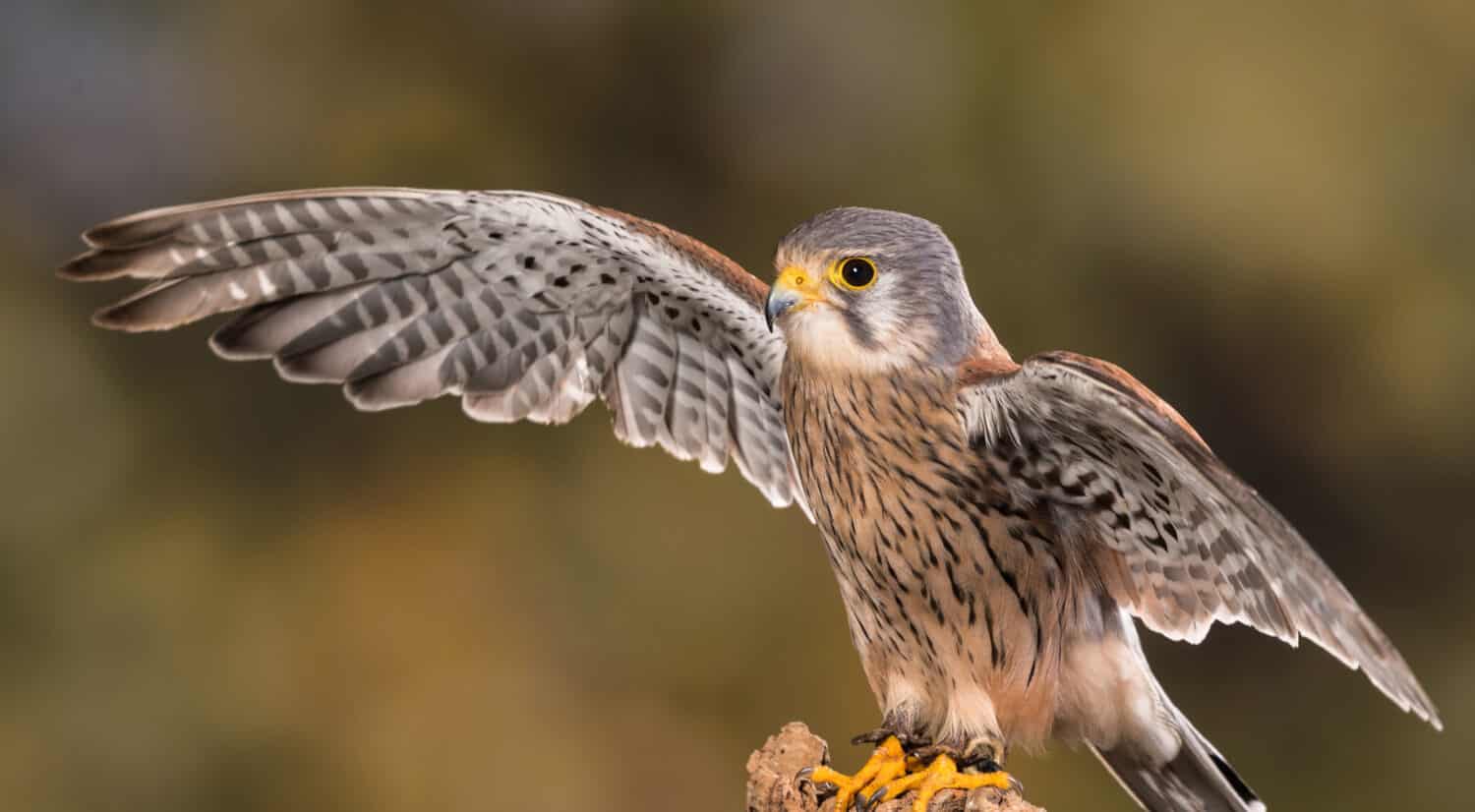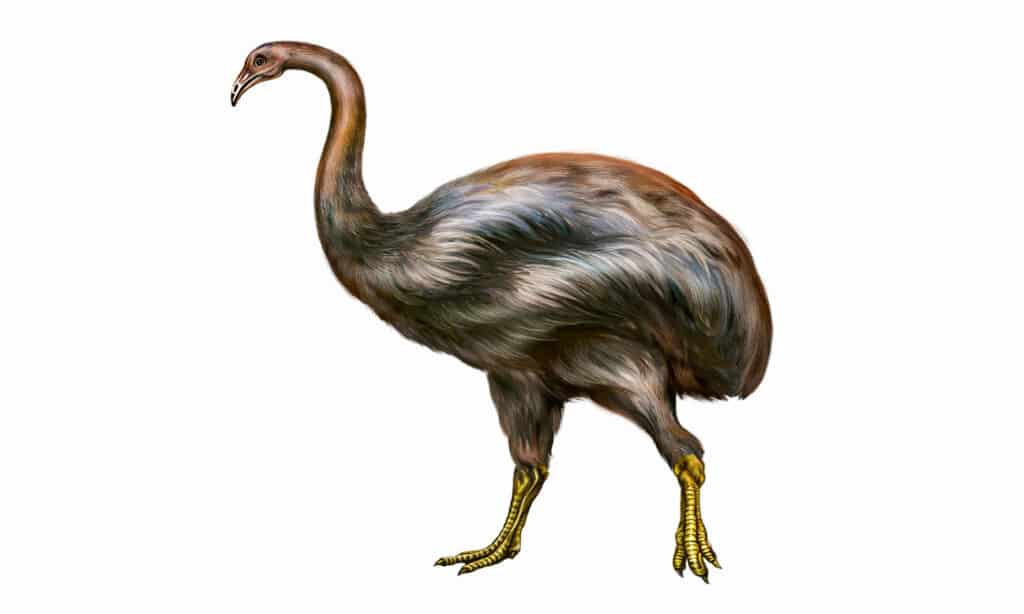Haast’s eagles were one of the largest true raptors, surpassing even the largest living vultures in size and weight. Females were much bigger than males, with estimates placing their weight between 22 to 37 pounds. These large ancient eagles had powerful talons and beaks, which they used to hunt and kill their prey. Their diet primarily consisted of large flightless birds, including the moa, which could be up to fifteen times larger than the eagle itself. Follow along to learn more about the largest eagle on Earth.
Haast’s Eagle: Largest Eagle on Earth
The Haast’s eagle had a wingspan of up to 10 feet, a body length of up to 4.7 feet, stood just over 2 feet tall, and could weigh up to 37 pounds.
| Haast’s Eagle |
|---|
| Wingspan: 9 to 10 feet |
| Body length: 4 feet 7 inches |
| Height: 2 feet 11 inches |
| Weight: 37 pounds |
The Haast’s eagle was the biggest eagle ever to exist. The eagle’s incredible size resulted from a phenomenon known as island gigantism, where smaller species grow larger to take advantage of abundant resources in their new environment.
Could the Haast’s Eagle Fly?

Haast’s eagles had short wings, which may have been helpful for flying around dense forests.
©Jakub Maculewicz/Shutterstock.com
There’s a lot of speculation about whether the Haast’s eagle had limited flight capabilities or was completely flightless. It appears this large bird had a knack for launching themselves into the air with a running start; they were impressive jumpers. But it remains a mystery whether their jumping antics were enough to allow them to take flight.
If this large ancient eagle were capable of flight, you wouldn’t see it soaring around like a bald eagle. Instead, the Haast’s eagle would prefer stalking prey in thick vegetation. Unlike eagles adapted for long-range soaring, the Haast’s eagle had relatively short wings, indicating that it was built for flying in dense forests. The type of thick forests that had limited space for wing extension. Instead of relying on large wings, they used their enlarged tail to create lift.
Eagle-Vulture Combination

The Haast’s eagle had a lot of vulture-like characteristics, some of which made it difficult to carry prey.
©Carmine Arienzo/Shutterstock.com
The largest eagle on Earth was a mash-up of 2 different species. The Haast’s eagle had a body combining vulture-like features with eagle-like characteristics. They likely attacked their prey like an eagle but fed on them more like a vulture. For instance, their vulture side made it impossible to carry their prey away, forcing them to eat kills on the spot.
Making the kills was easy, thanks to their sharp talons. Its feet were equipped with long talons, similar in form to the harpy eagle. The largest claws could grow up to 3.5 long, nearly the size of tiger claws. This may have earned their nickname, “flying tiger.” Their eagle-like talons helped them attack and instantly immobilize prey. They also had a powerful beak and larger jaws compared to most modern eagles.
Enormous Wingspan of the Haast’s Eagle

The little eagle of Australia is likely related to the extinct Haast’s eagle.
©nataliatamkovich/Shutterstock.com
The Haast’s eagle had a wingspan of 8.6 to 10 feet wide. That means they had a greater weight-to-wing size ratio than eagles today. Its skeletal features suggest a connection to the little eagle of Australia, indicating relatively shorter wings and stronger legs than other eagles.
What Did the Haast’s Eagle Eat?

Moas could grow to be 13 feet tall and weigh over 500 pounds.
©Liliya Butenko/Shutterstock.com
The Haast’s eagle lived in New Zealand and preyed on the moas. This extinct group of birds could weigh as much as 500 pounds and would tower over them. While the eagle couldn’t lift a moa off the ground and take flight, its sharp talons could rip flesh and crush bones.
Moas, we’re the tallest birds ever to exist; they’re the giant cousin of the ostrich or emu. They even have ties to the extinct elephant bird from Madagascar. These avian giants were nearly as tall as giraffes, although smaller ones were turkey-sized. Similar to an emu, these birds couldn’t fly.
Why Did the Largest Eagle on Earth Go Extinct?
Why did the Haast’s eagle go extinct? Several factors led to their demise. The biggest one was the arrival of humans, who began clearing land and hunting. By 1400 AD, most of its forest habitat had been cleared by fire, and its primary food source (moas) was hunted to extinction.
Reasons the largest eagle on Earth went extinct:
- Human hunting activities
- Territory needs
- Lack of food
- Low reproductive rate
The arrival of humans in New Zealand sealed the fate of this large ancient bird. But there were other factors that contributed, too, such as habitat needs and reproductive rates. Haast’s eagles require large territories, which makes sense considering their large size and big appetites. This need to spread out leads to low population density and low overall numbers. To make matters worse, they likely had a low reproductive rate. Once their numbers began dwindling, making a comeback would have become impossible.
Bald Eagle or Haast’s Eagle: Spotting the Differences

On average bald eagles have a 7-foot wingspan, which is 3 feet shorter than the Haast’s eagle.
©Marcy Herrick/Shutterstock.com
What is the difference between a bald eagle and a Haast’s eagle? Haast eagles have a wingspan that averages around 9 to 10 feet and can weigh as much as 37 pounds. On the other hand, bald eagles weigh up to 14 pounds and have a 7-foot wingspan. And while bald eagles sometimes target large prey like deer, they typically feed on smaller animals like fish. In contrast, the largest eagle on Earth had a pretty big appetite. Haast’s eagles loved targeting large extinct birds, like moas, weighing as much as 500 pounds.
The photo featured at the top of this post is © John Megahan / CC BY 2.5 – License / Original
Thank you for reading! Have some feedback for us? Contact the AZ Animals editorial team.






